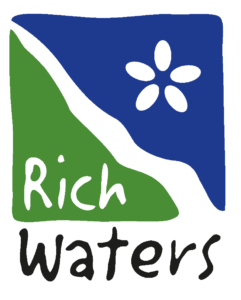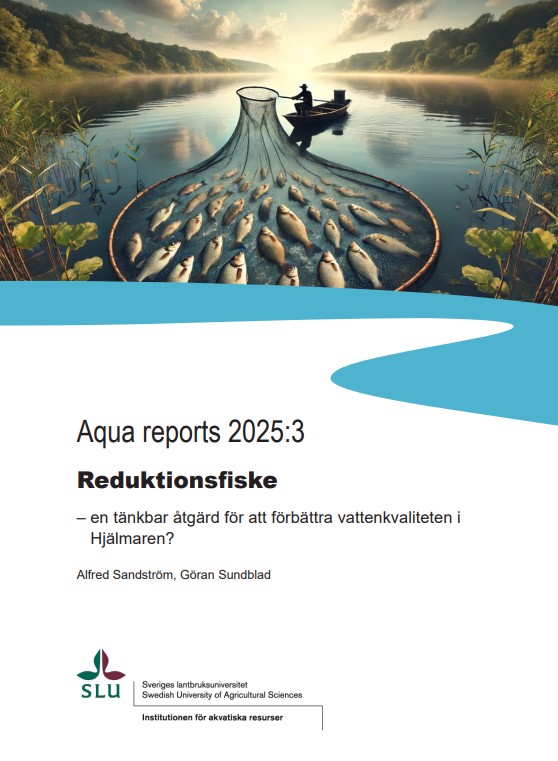Summary
Lake Hjälmaren is a large and relatively productive lake in central Sweden. It has substandard water quality due to problems with eutrophication. According to the Water Framework Directive, the requirements for good ecological and chemical status are currently not being met. One proposed method to improve water quality is large-scale removal of fish. This method involves selectively removing large amounts of certain fish species, such as roach, bream, and silver bream. Removal of fish can have positive effects on water quality, measured as water transparency and chlorophyll a, primarily in small, shallow, and heavily eutrophic lakes in Denmark and the Netherlands. Several mechanisms are believed to contribute to the effects of removing fish from lakes. The most important are: i) reduced biomass of zooplankton-eating fish favors zooplankton that eat phytoplankton, resulting in more clear water; ii) removal of fish results in extraction of phosphorus (approximately 0.8% of the body weight) from the system via the landed fish and iii) some cyprinids, such as bream, disturb the sediments and contribute to phosphorous leakage via their foraging of benthic prey.
This report attempts to assess the risks and conditions for removal of fish to improve water quality in Hjälmaren. The analysis was based on a literature review that identified important factors contributing to the potential outcome and necessary extent of the removal. The literature review was compared to available data from previous fish surveys in Hjälmaren, new data collected via boat electrofishing, and data obtained from small-scale commercial fisheries including age analyses of bream.
The main findings were:
- The total fish biomass in Hjälmaren varied between habitats and depth zones but was estimated at a minimum of about 3,800 tonnes, corresponding to at least 78 kg per hectare. This is most likely an underestimation of the actual biomass because none of the sampling methods used provide a complete estimate of total biomass. More than half of the fish biomass consisted of cyprinids, and common bream was the dominant cyprinid in all habitats and basins.
- Common bream biomass was also estimated using a cohort analysis, based on growth, size distribution, and landings in the fisheries as well as assumptions regarding natural mortality. The biomass of the adult common bream population varied (depending on the assumption of natural mortality) between 800 and 2,080 tonnes. Fishing mortality was low in all analyses.
- The fishing pressure on the cyprinid populations in Hjälmaren appears to be low. In 2023, commercial fishing reported a total landing of common bream of 66 tonnes in Hjälmaren, compared to almost 100 tonnes in Lake Vänern and just over 2 tonnes in Lake Mälaren. Age analyses showed that the common bream population grows slowly and contains individuals of very high age. The average age in the catch was 15 years and the oldest individual was 45 years old, indicating that mortality likely is very low.
- Removal of fish in Hjälmaren would require a very extensive effort, between 1,010 and 14,500 tonnes per year depending on what assumptions and recommendations that are applied. The higher value was derived from an extensive meta-analysis of smaller lakes and ponds that concluded that it was necessary to remove 300 kg fish per ha and year to reach an improvement of water transparency by 0.5 meters. Such an extensive fish removal would require establishing an organization and infrastructure for handling the large catches.
It is doubtful whether Hjälmaren has the necessary conditions for removal of fish to successfully improve water quality. The effect of fish removal on water quality has been shown to decrease with increasing lake size. Hjälmaren is significantly larger than the largest lakes where removal has previously been conducted and evaluated. Another important factor is the depth conditions. Shallow lakes, where vegetation can recolonize large areas following improved water visibility due to removal of fish, have been shown to be more likely to have positive long-term responses in water quality. Hjälmaren has two water bodies that are very shallow, but the proportion of lake area suitable for underwater vegetation is nevertheless relatively low compared to lakes where removal of fish has been successful. There are also other aspects indicating that Hjälmaren does not have suitable prerequisites for removal of fish to successfully improve water quality: a relatively long retention time, high internal phosphorous loading, relatively low pre- removal phosphorous concentrations compared to successful removals, presence of macrozooplankton and mysids which eat zooplankton and risk taking over the role of removed zooplankton-eating fish, and periodic occurrence of wind/wave-induced turbidity.
To summarize, our assessment is that there is insufficient evidence of removal of fish in Hjälmaren to be successful, that a removal fishery would need to be extensive and therefore expensive, that there is a significant risk of not achieving the desired result, and that there are also risks of unexpected and potentially negative consequences for both the fisheries and ecosystem.
Such negative effects on fisheries, especially bream and pikeperch (who benefit from higher nutrient concentrations), highlight the conflict between considerations of the importance of fisheries, society’s need to find ways to attain self-sufficiency as regards sea food in times of crisis, and the current goals of water management to improve water quality. How to handle conflicting environmental and resource goals is a management question to consider in future work.
An alternative to removal of fish is to support increased removal of cyprinids within the framework of the existing small-scale fishery in Hjälmaren. Common bream, in particular, has received increased attention as a food fish in recent years, leading to a small but slowly growing demand. Such a fisheries would not accomplish the significant catches required in a fish removal programme but it could be an alternative that is associated with less risk, lower cost, and in the long run, a more sustainable way to contribute to a gradual reduction of phosphorous in Hjälmaren through the continuous extraction of phosphorous via the landed catch.
Although a full-scale fish removal programme is not recommended, the theories and processes associated with this measure can serve as inspiration for enhancing the knowledge about the ecosystem in Hjälmaren and improve governance by integrating the role of fish and fisheries with water quality management.



